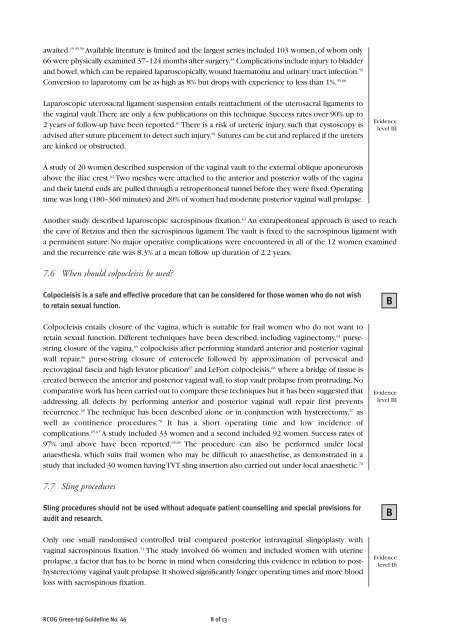The Management of Post Hysterectomy Vaginal Vault Prolapse ...
The Management of Post Hysterectomy Vaginal Vault Prolapse ...
The Management of Post Hysterectomy Vaginal Vault Prolapse ...
You also want an ePaper? Increase the reach of your titles
YUMPU automatically turns print PDFs into web optimized ePapers that Google loves.
awaited. 15,55,59 Available literature is limited and the largest series included 103 women, <strong>of</strong> whom only66 were physically examined 37–124 months after surgery. 55 Complications include injury to bladderand bowel, which can be repaired laparoscopically, wound haematoma and urinary tract infection. 55Conversion to laparotomy can be as high as 8% but drops with experience to less than 1%. 55,60Laparoscopic uterosacral ligament suspension entails reattachment <strong>of</strong> the uterosacral ligaments tothe vaginal vault. <strong>The</strong>re are only a few publications on this technique. Success rates over 90% up to2 years <strong>of</strong> follow-up have been reported. 61 <strong>The</strong>re is a risk <strong>of</strong> ureteric injury, such that cystoscopy isadvised after suture placement to detect such injury. 61 Sutures can be cut and replaced if the uretersare kinked or obstructed.Evidencelevel IIIA study <strong>of</strong> 20 women described suspension <strong>of</strong> the vaginal vault to the external oblique aponeurosisabove the iliac crest. 62 Two meshes were attached to the anterior and posterior walls <strong>of</strong> the vaginaand their lateral ends are pulled through a retroperitoneal tunnel before they were fixed. Operatingtime was long (180–360 minutes) and 20% <strong>of</strong> women had moderate posterior vaginal wall prolapse.Another study described laparoscopic sacrospinous fixation. 63 An extraperitoneal approach is used to reachthe cave <strong>of</strong> Retzius and then the sacrospinous ligament. <strong>The</strong> vault is fixed to the sacrospinous ligament witha permanent suture. No major operative complications were encountered in all <strong>of</strong> the 12 women examinedand the recurrence rate was 8.3% at a mean follow up duration <strong>of</strong> 2.2 years.7.6 When should colpocleisis be used?Colpocleisis is a safe and effective procedure that can be considered for those women who do not wishto retain sexual function.Colpocleisis entails closure <strong>of</strong> the vagina, which is suitable for frail women who do not want toretain sexual function. Different techniques have been described, including vaginectomy, 64 pursestringclosure <strong>of</strong> the vagina, 65 colpocleisis after performing standard anterior and posterior vaginalwall repair, 66 purse-string closure <strong>of</strong> enterocele followed by approximation <strong>of</strong> pervesical andrectovaginal fascia and high levator plication 67 and LeFort colpocleisis, 68 where a bridge <strong>of</strong> tissue iscreated between the anterior and posterior vaginal wall, to stop vault prolapse from protruding. Nocomparative work has been carried out to compare these techniques but it has been suggested thataddressing all defects by performing anterior and posterior vaginal wall repair first preventsrecurrence. 69 <strong>The</strong> technique has been described alone or in conjunction with hysterectomy, 67 aswell as continence procedures. 70 It has a short operating time and low incidence <strong>of</strong>complications. 65,67 A study included 33 women and a second included 92 women. Success rates <strong>of</strong>97% and above have been reported. 65,69 <strong>The</strong> procedure can also be performed under localanaesthesia, which suits frail women who may be difficult to anaesthetise, as demonstrated in astudy that included 30 women having TVT sling insertion also carried out under local anaesthetic. 70BEvidencelevel III7.7 Sling proceduresSling procedures should not be used without adequate patient counselling and special provisions foraudit and research.Only one small randomised controlled trial compared posterior intravaginal slingoplasty withvaginal sacrospinous fixation. 71 <strong>The</strong> study involved 66 women and included women with uterineprolapse, a factor that has to be borne in mind when considering this evidence in relation to posthysterectomyvaginal vault prolapse. It showed significantly longer operating times and more bloodloss with sacrospinous fixation.BEvidencelevel IbRCOG Green-top Guideline No. 46 8 <strong>of</strong> 13
















